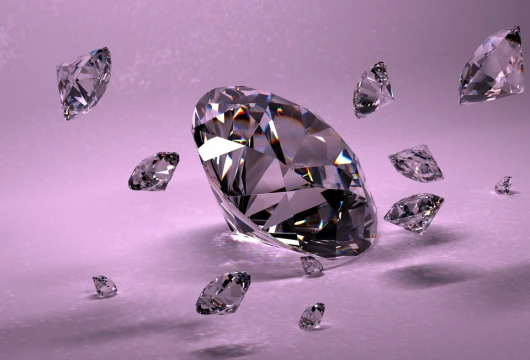Transforming Lab-Grown Diamond Production with Renewable Energy
India and China are at the forefront of the global lab-grown diamond industry, producing 72% of the world’s supply. This remarkable achievement places India as a key player in shaping the future of the diamond industry, where affordability and sustainability converge. However, as the industry grows, so does its energy-intensive carbon footprint—an issue India must address through innovation and renewable energy integration.
The Global Lab-Grown Diamond Landscape
Lab-grown diamonds, often called the affordable and ethical alternative to natural diamonds, have gained immense popularity in recent years. According to the Natural Diamonds Council, the market has expanded to an estimated 15–20 million carats annually, with India producing 26% and China leading with 46% of the global output.
While the High-Pressure, High-Temperature (HPHT) method dominates diamond production in China, India predominantly relies on the Chemical Vapor Deposition (CVD) method. Although the CVD process produces high-quality diamonds, it is significantly more energy-intensive, relying on high-energy microwaves to create the plasma necessary for diamond growth.
The Energy Challenge: A Carbon Footprint Perspective
Lab-grown diamond production demands a substantial amount of energy. Factories operate at extreme temperatures—reaching up to 1,500°C—and require consistent cooling systems and environmental stabilization to maintain the integrity of the diamond growth process.
In India, the carbon emissions for producing a single polished carat of lab-grown diamond average 612 kg CO2e. This figure surpasses the 523 kg CO2e in China and the 260 kg CO2e in the European Union. This disparity is mainly due to India’s reliance on coal-powered electricity, which accounts for 74% of its energy mix used in diamond manufacturing.
However, the industry holds significant potential for improvement. If production were powered entirely by renewable energy, emissions could be drastically reduced to as low as 17 kg CO2e per polished carat. This shift would position India as a global leader in sustainable diamond production.
Renewable Energy: The Key to Sustainability
Recognizing the environmental impact of its current energy reliance, India’s lab-grown diamond industry is exploring solutions to integrate renewable energy into production processes. Solar, wind, and hydropower present viable alternatives to coal-generated electricity, offering a path to significantly lower emissions while maintaining production growth.
Governments and industry stakeholders are collaborating to develop policies and infrastructure that encourage the adoption of clean energy. Investments in renewable energy plants near diamond production hubs are also gaining momentum, promising a sustainable future for the industry.
India’s Commitment to Sustainability
India’s leadership in the lab-grown diamond market reflects its ability to blend technological innovation with economic growth. The country’s use of the CVD process demonstrates its commitment to producing high-quality diamonds that meet global standards. The focus is on refining this process to align with sustainability goals.
The Natural Diamonds Council emphasizes that the transition to renewable energy is an environmental necessity and an economic opportunity. Sustainable practices will enhance India’s competitiveness in the global market, where consumers increasingly prioritize ethical and eco-friendly products.
A Global Collaboration for a Greener Future
India’s efforts to reduce the carbon footprint of lab-grown diamonds are part of a more significant global movement. Collaborative initiatives with international organizations and countries like the European Union can help accelerate the adoption of renewable energy and innovative technologies.
China’s transition from coal-powered to greener alternatives also serves as a benchmark. With its significant production share, China’s progress toward sustainability underscores the potential for shared solutions and mutual growth in the industry.
Consumer Trends Driving Sustainability
Younger consumers who value affordability, sustainability, and ethical sourcing drive the growing demand for lab-grown diamonds. As awareness of carbon footprints rises, buyers seek transparency in production processes. India’s lab-grown diamond industry has an opportunity to lead by example, showcasing its commitment to reducing emissions and embracing renewable energy.
Brands prioritizing sustainability will likely attract environmentally conscious consumers, further fueling the industry’s growth. Certifications and labeling systems that highlight the eco-friendliness of lab-grown diamonds can also strengthen consumer trust and loyalty.
A Brighter Future for Lab-Grown Diamonds
The journey toward sustainable diamonds is challenging but rewarding. India’s ability to adapt its energy practices and invest in renewable solutions will determine its leadership in the global market. By embracing sustainability, India can redefine the narrative of lab-grown diamonds, making them synonymous with eco-friendly luxury.
As the industry transitions, stakeholders must work together to address energy challenges and leverage technological advancements. The shift toward renewable energy reduces carbon emissions and enhances the resilience and longevity of the lab-grown diamond sector.
Transforming Lab-Grown Diamond Production with Renewable Energy
India’s lab-grown diamond industry stands at a critical juncture. With its prominent position in global production, the country has the power to shape the future of sustainable diamonds. By investing in renewable energy and prioritizing eco-friendly practices, India is setting the stage for a greener, more ethical diamond industry.
As the world moves toward a sustainable future, India’s lab-grown diamonds can shine as a beacon of innovation and environmental responsibility, proving that luxury and sustainability can go hand in hand.
For more in-depth analysis and inspiring climate news, click here.

